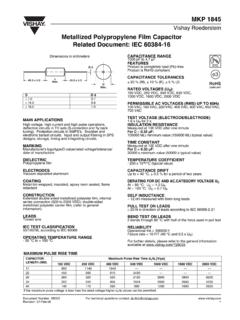Transcription of HISTORY AND SOCIAL SCIENCE STANDARDS OF EARNING …
1 HISTORY AND SOCIAL SCIENCE STANDARDS OF LEARNING. curriculum framework 2008. Virginia and United States HISTORY Board of Education Commonwealth of Virginia Copyright 2008. by the Virginia Department of Education P. O. Box 2120. Richmond, Virginia 23218-2120. All rights reserved. Reproduction of these materials for instructional purposes in public school classrooms in Virginia is permitted. Superintendent of Public Instruction Billy K. Cannaday, Jr. Chief Deputy Superintendent of Public Instruction Patricia I. Wright Assistant Superintendent for Instruction Linda M. Wallinger Office of Elementary Instructional Services Mark R. Allan, Director Betsy S. Barton, HISTORY and SOCIAL SCIENCE Specialist Office of Middle and High School Instructional Services Felicia D. Dyke, Director Beverly M. Thurston, HISTORY and SOCIAL SCIENCE Coordinator Edited by the CTE Resource Center NOTICE. The Virginia Department of Education does not unlawfully discriminate on the basis of race, color, sex, national origin, age, or disability in employment or in its educational programs or services.
2 INTRODUCTION. The HISTORY and SOCIAL SCIENCE STANDARDS of Learning curriculum framework 2008, approved by the Board of Education on July 17, 2008, is a companion document to the 2008 HISTORY and SOCIAL SCIENCE STANDARDS of Learning for Virginia Public Schools. The curriculum framework amplifies the STANDARDS of Learning by defining the content understandings, knowledge, and skills that are measured by the STANDARDS of Learning assessments. The curriculum framework provides additional guidance to school divisions and their teachers as they develop an instructional program appropriate for their students. It assists teachers in their lesson planning by identifying the essential content understandings, knowledge, and intellectual skills that should be the focus of instruction for each standard. Hence, the framework delineates with greater specificity the content that all teachers should teach and all students should learn. The curriculum framework consists of at least one framework page for every Standard of Learning.
3 Each of these pages is divided into four columns, as described below: Essential Understandings This column includes the fundamental background information necessary for answering the essential questions and acquiring the essential knowledge. Teachers should use these understandings as a basis for lesson planning. Essential Questions In this column are found questions that teachers may use to stimulate student thinking and classroom discussion. The questions are based on the standard and the essential understandings, but may use different vocabulary and may go beyond them. Essential Knowledge This column delineates the key content facts, concepts, and ideas that students should grasp in order to demonstrate understanding of the standard. This information is not meant to be exhaustive or a limitation on what is taught in the classroom. Rather, it is meant to be the principal knowledge defining the standard. Essential Skills This column enumerates the fundamental intellectual abilities that students should have what they should be able to do to be successful in accomplishing historical and geographical analysis and achieving responsible citizenship.
4 The curriculum framework serves as a guide for STANDARDS of Learning assessment development; however, assessment items may not and should not be verbatim reflections of the information presented in the curriculum framework . HISTORY and SOCIAL SCIENCE STANDARDS of Learning curriculum framework 2008: Virginia and United States HISTORY iii STANDARD , b, c, d, e, f, g, h, i The student will demonstrate skills for historical and geographical analysis and responsible citizenship, including the ability to a) identify, analyze, and interpret primary and secondary source documents, records, and data, including artifacts, diaries, letters, photographs, journals, newspapers, historical accounts, and art, to increase understanding of events and life in the United States;. b) evaluate the authenticity, authority, and credibility of sources;. c) formulate historical questions and defend findings, based on inquiry and interpretation;. d) develop perspectives of time and place, including the construction of maps and various timelines of events, periods, and personalities in American HISTORY .
5 E) communicate findings orally and in analytical essays or comprehensive papers;. f) develop skills in discussion, debate, and persuasive writing with respect to enduring issues and determine how divergent viewpoints have been addressed and reconciled;. g) apply geographic skills and reference sources to understand how relationships between humans and their environment have changed over time;. h) interpret the significance of excerpts from famous speeches and other documents;. i) identify the costs and benefits of specific choices made, including the consequences, both intended and unintended, of the decisions and how people and nations responded to positive and negative incentives. The various skills identified in this standard are cited, as applicable, in the Essential Skills columns of the charts throughout this curriculum framework , with the exception of skills e and f. Students should have opportunities to practice communicating orally and in writing, discussing, debating, and persuading, but these skills will not be assessed on the STANDARDS of Learning test.
6 All other skills listed above will be assessed on the test, and teachers should incorporate them into instruction throughout the year. HISTORY and SOCIAL SCIENCE STANDARDS of Learning curriculum framework 2008: Virginia and United States HISTORY 1. STANDARD The student will describe how early European exploration and colonization resulted in cultural interactions among Europeans, Africans, and American Indians. Essential Understandings Essential Questions Essential Knowledge Essential Skills Early European exploration Why did Europeans settle Characteristics of early exploration and settlements in the New World Identify, analyze, and and colonization resulted in in the English colonies? New England was settled by Puritans seeking freedom from religious interpret primary and the redistribution of the persecution in Europe. They formed a covenant community based on the secondary source world's population as How did their motivations principles of the Mayflower Compact and Puritan religious beliefs and were documents, records, and millions of people from influence their settlement often intolerant of those not sharing their religion.
7 They also sought data to increase Europe and Africa voluntarily patterns and colony economic opportunity and practiced a form of direct democracy through understanding of events and involuntarily moved to structures? town meetings. and life in the United the New World. The Middle Atlantic region was settled chiefly by English, Dutch, and States. ( ). In what ways did the German-speaking immigrants seeking religious freedom and economic Exploration and colonization cultures of Europe, opportunity. Formulate historical initiated worldwide Africa, and the Americas Virginia and the other Southern colonies were settled by people seeking questions and defend commercial expansion as interact? economic opportunities. Some of the early Virginia settlers were cavaliers, findings, based on agricultural products were , English nobility who received large land grants in eastern Virginia from inquiry and exchanged between the What were the the King of England.
8 Poor English immigrants also came seeking better lives interpretation. ( ). Americas and Europe. In consequences of the as small farmers or artisans and settled in the Shenandoah Valley or western time, colonization led to ideas interactions of European, Virginia, or as indentured servants who agreed to work on tobacco Develop perspectives of of representative government African, and American plantations for a period of time to pay for passage to the New World. time and place. ( ). and religious tolerance that cultures? Jamestown, established in 1607 by the Virginia Company of London as a over several centuries would business venture, was the first permanent English settlement in North inspire similar America. The Virginia House of Burgesses, established by the 1640s, was transformations in other parts the first elected assembly in the New World. It has operated continuously of the world. and is known today as the General Assembly of Virginia.
9 Interactions among Europeans, Africans, and American Indians The explorations and settlements of the English in the American colonies and Spanish in the Caribbean, Central America, and South America, often led to violent conflicts with the American Indians. The Indians lost their traditional territories and fell victim to diseases carried from Europe. By contrast, French exploration of Canada did not lead to large-scale immigration from France, and relations with native peoples were generally more cooperative. The growth of an agricultural economy based on large landholdings in the Southern colonies and in the Caribbean led to the introduction of slavery in the New World. The first Africans were brought against their will to Jamestown in 1619 to work on tobacco plantations. HISTORY and SOCIAL SCIENCE STANDARDS of Learning curriculum framework 2008: Virginia and United States HISTORY 2. STANDARD The student will describe how the values and institutions of European economic and political life took root in the colonies and how slavery reshaped European and African life in the Americas.
10 Essential Understandings Essential Questions Essential Knowledge Essential Skills Economic and political How did the economic activity and Economic characteristics of the Colonial Period Identify, analyze, and interpret institutions in the colonies political institutions of the three The New England colonies developed an economy primary and secondary source developed in ways that were colonial regions reflect the based on shipbuilding, fishing, lumbering, small-scale documents, records, and data to either typically European or were resources and/or the European subsistence farming, and eventually, manufacturing. increase understanding of events distinctively American, as origins of their settlers? The colonies prospered, reflecting the Puritans' strong and life in the United States. climate, soil conditions, and belief in the values of hard work and thrift. ( ). natural resources shaped regional Why was slavery introduced into The middle colonies of New York, New Jersey, economic development.
















